All Digital Parametric EQ’s are the same.
Read the entire post to fully understand the statement.
You might be sitting there thinking (hey my Waves, URS, Vox, blah blah sound completely different). With some emulation plugins you have EQ+X. X can = Saturation, bandwidth limits, softclips, offset numerical values, & so on. Separate the X variable what do you have? The EQ algorithm.
Lets look at Digital EQ types.
- Parametric/Series – “PEQ”. (These are the most common track EQ’s, Most channelstrip, Plugin EQ’s, Bundled DAW eq’s, its never-ending. )
- Parallel – More uncommon in the digital world.
- Linear phase – Commonly mislabeled as “Mastering” EQ’s
These 3 types perform differently. But PEQ’s are the most commonly used/emulated.
You can take any respectable PEQ and create all of the curve/phase characteristics of any other digital PEQ. The Q, gain, proportional relationships, & numerical values are a developer decision. You can’t compare EQ’s by matching dials & numbers, You will get different results. If you use an analyzer & match signals/curves you will unveil “the magic”.
Digital emulations for the most part are marketing hype in my opinion. If you use a variable PEQ like the one that comes native with your host & saturation tools, you will be able to recreate just about any classic console EQ aesthetic you have heard.
Don’t just take my word for it, listen to the developers.
Read this from Algorithmix
Quote:The truth is that with a properly designed, fully parametric analytic PEQ, every amplitude and phase characteristic of any other equalizer setup can be recreated. Of course, the contribution of distortions to the specific sound of a particular analog equalizer caused by the respective electronics has to be considered. If the distortions are ‘good’, they may make certain applications sound better.
Conclusion?
As I said I’ve found emulation plugins for the most part to be hype. But you might find the user interface more creative, Or you might like the type of saturation the plugin uses in its design. (If included at all.)
If you find yourself asking the question “is my mix missing that magic EQ?????” Don’t. Your EQ needs are fully covered using a fully variable EQ & a saturation tool of choice.
The quality variables come down to, unlocked filter flexibility, internal resolution, oversampling capabilities, & so on. There is no magic in audio DSP, It’s math. If you make your EQ decisions while listening, you can get to the same aesthetic result with tools at hand.
Example.
Everyone likes null tests right =)
So I took two supposedly “drastically different classed” Digital parametric EQ’s.
The external DSP hosted SSL Duende X-EQ, & compared it with Sonars native Sonitus EQ.
Test signal = pink noise, tone, & a drum mix. FYI – Noise is far from lacking dynamics. It’s actually extremely dynamic. The full bandwidth signal gives the impression of a common static level. Use a bandpass & you will see how chaotically dynamic it is. Pink noise will stress any test much harder then a typical mastered music track. & yes it nulls with music as well.
This was the X-eq setup.
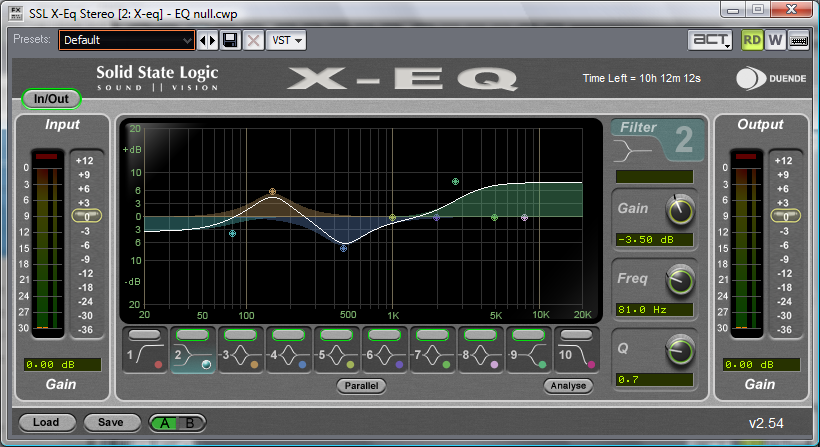
This is the Sonar EQ with the setting I tweaked to null.
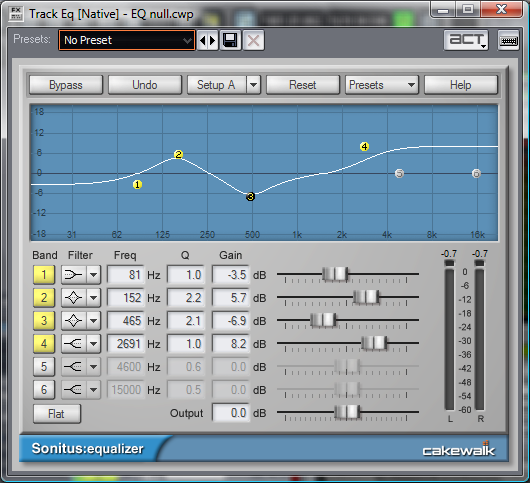
To get the settings I panned the channels hard L&R and matched the frequency response. You can see the 2 overlapping lines. Blue = X-eq, Orange = Sonar. You can see single orange pixels if you look close.

This is a bunch of stereo image meters that show the lack of phase differences.
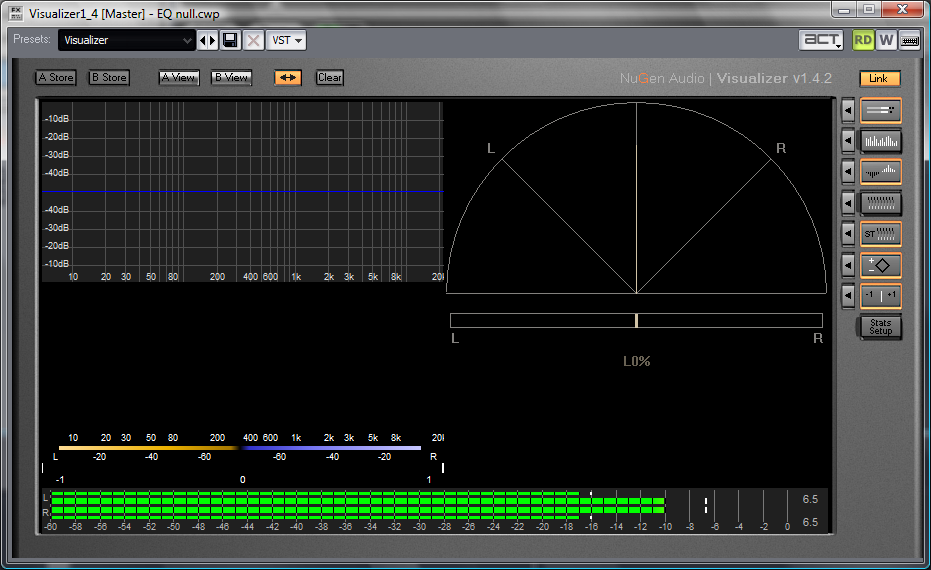
This is what happens if you bypass one of the EQ’s for comparison.

—————
Other comparisons.
I decided to take it a step further.
How close could I match the waves SSL with analog on.
So instead of using sonar & my usual saturation tools I decided to try it with all native Ableton Live plugins. At 1st I was having a hell of a time trying to match the EQ Phase. That is until I turned off Live’s Hi quality EQ mode.
Live oversamples with Hi quality on.
Here are the EQ setups.
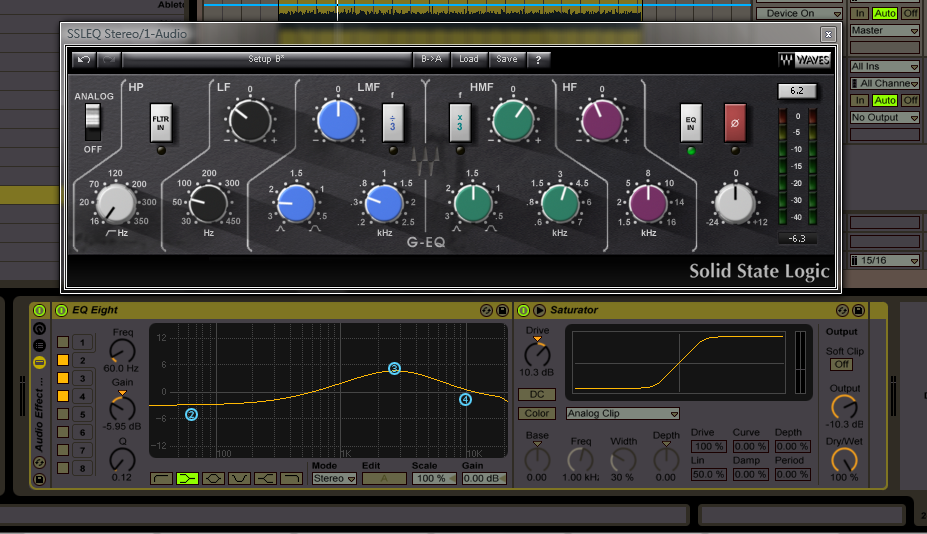
Frequency Response with saturation.
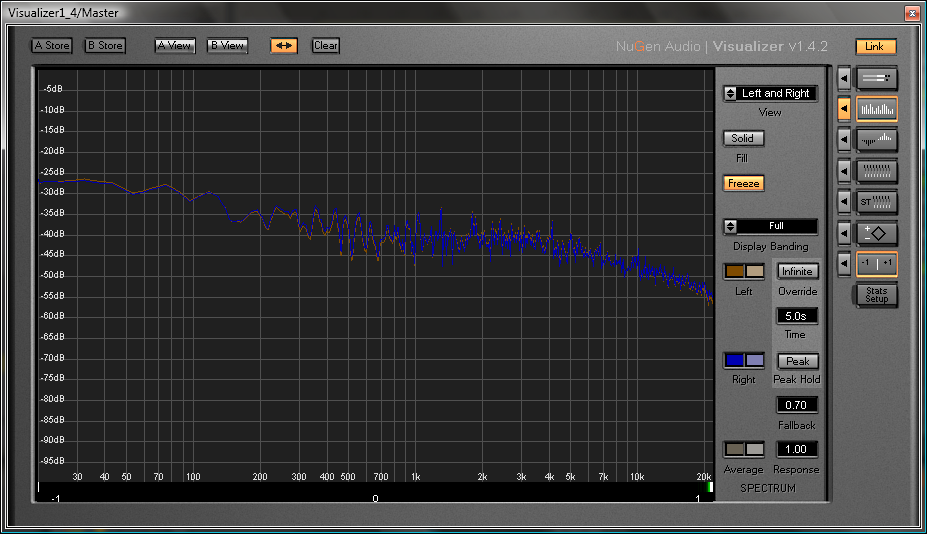
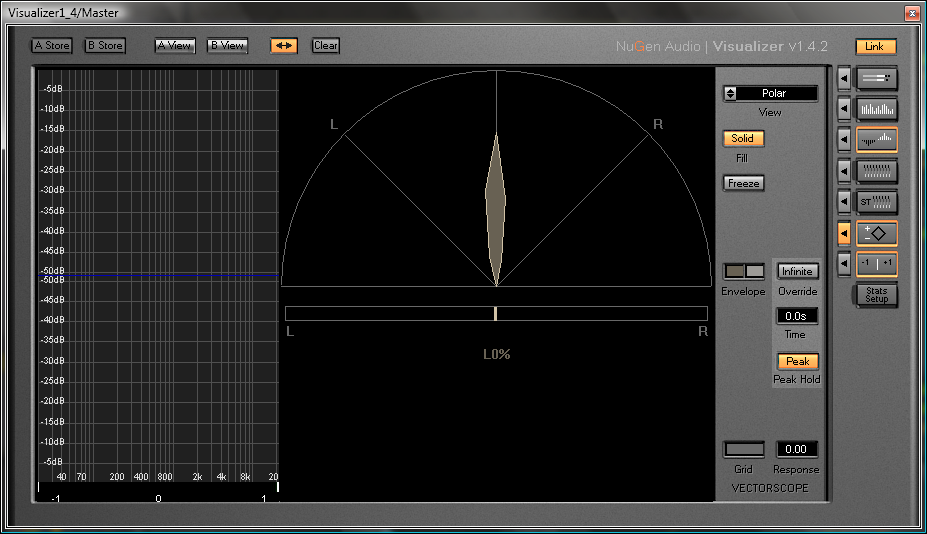
The left measures frequency differences & the right is the phase relationship. Not bad, it’s near mono. Pretty interesting for completely different tools.
..
As requested Impulse/Time Domain analysis.

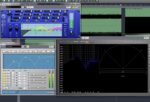
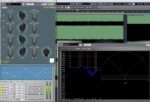
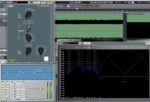
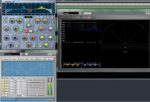
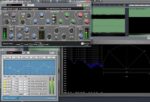
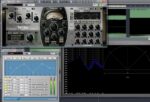
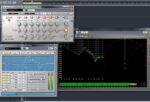




really impressive tests.
very nice article!
congrats
LOL – i love it. I’ve been feeling like everyone has been getting duped by these “vintage GUI’s” for a long time.
The proof is in the pudding. Thanks for doing this.
Very interesting tests. Are you able to do test with UAD plugins?
No i don’t have a UAD at my disposal. Anyone care to donate? =)
How much did you spend to get theses results ? I don’t deny your tests (looks serious), but… When I use a plugin which emulate a hardware, it’s for the “sound” but also for the efficiently of the controls… Setting up a UAD 1073, 88RS or Pultec for a vocal track can takes me only a minute to have the result I expect… Even “if” you can null it with a generic EQ, how much time do you have to spend to get the same result ?? Is it even possible if you’re not trying to null a snapshot ? Don’t forget all theses are tools, and the way they get you to the result is as much important as the sound you get from (at least for me, doing it for living). Thanx for your time anyway, it’s interesting results.
Not really the point at hand. I’m not suggesting everyone should match EQ curves. What I wanted to share is that a fully variable PEQ can emulate them all.
If you use your ears & dial in the tone you desire, you will not be missing some “magical” quality of some digital vintage emulation. You won’t get improved fidelity by switching to a different EQ.
But I will say with an analyzer it’s not to hard to match curves at all. It’s a balance of convenience vs price that one most decide on for themselves. For myself I prefer to use my ears & dial in the curves I desire. I’ve taken the time to learn the audible effect of creating curve shapes. But for some having the “preset” classic curves found in emulations saves them time. It can be less distracting or have a more creative work-flow. I fully understand the importance of that. For myself until a digital EQ algorithm contains not only the saturation stage but also the phase/delay characteristics of the analog counterparts, there is no reason for me other then GUI preference to use one digital PEQ over the other.
Let me add an analogy with cars to clear my point. What you’re saying is : every car can make you go to point A to B. And you’re right. With your tests, you prove that a commercial who say “with my car you’ll can reach a point the other cars can’t” is wrong.
But they can say “with my car, it will be faster, more comfortable, and you’ll not loose yourself cause we have a GPS”. So YES you’ll arrive to the same point B with a Porsche, Mercedes, Hyundai or the new TATA Nano (or even bicycle !). The point is, when you’re work is traveling, or if you have enough money and likes to travel, some cars are really better than others at what they do. It’s not about the design of the car…
I understand your view. I really love classic analog hardware for dedicated tasks. But when I’m driving my “digital car” I pick a single vehicle that can be anything from a bicycle to a tank.
Hey..very impressive !
I’d really appreciate if you could also check these two EQs:
– Eiosis AirEQ (they claim to emulate an analogue console curves unlike in most common digital EQs). You should be able to demo it and also please read what they say in their website.
– TriTone digital plugins (AngleTone and HydraTone)
Gary.
Also, here’s some info about the
AMLT Technlogy offered in AirEQ
http://www.eiosis.com/amlt
i think you should check it out just to know better what to test 🙂
looking forward for the results!
Just checked out the AirEQ & added a screen-shot.. Nice EQ, I like that it doesn’t give you number indication & makes you use your ears. Not sure if AMLT is anything more then over sampling. I was still able the match the bands. Not sure what “AIR” boost is actually is doing.
“AirEQ also features a special “Air” band, which is a new type of filter that helps you to restore or to add brightness to the sound. ”
I’m guessing harmonics & or saturation.
Like i said overall great EQ but not seeing anything that doesn’t fall into EQ + X addon…
Wow. You are definitely the man. That really is the long and short of it. You don’t need the expensive emulators. I’m guilty of an expensive Waves purchase. Most DAW’s really do come with the tools you need to meet the exact same demand. i know better and should have thought about it. Superb tests and examples. Thanks for the insight.
hogwash
you’re my kind of guy. don’t believe the hype!
of course i thought this was nonsense until i took my much-loved sonalksis eq and the much-hated live7 eq and was able to line them up 99% perfectly. for some of the alternative sonalksis shelf curves i needed 2 live shelves, but once i found that out, it was easy. i still like the sonalksis, because it gives me access to good curves immediately. but now i see that with a bit of practice i could get the same results out of the live eq.
i just wonder how to interpret this. same spectrum and no phase difference means they sound the same, right? so… do live eq and sonalksis have the same x (distortions) or just a minimum amount of them?
i gather from this post that there is just 1 peq design. is that true? if so, designing an eq boils down to taking that design, making sure the parameters map in a ‘musical’ way and then add distortions to give the eq character.
and is it differently in the analog domain? or is there only 1 design too? i suppose that there, even choosing different capacitors changes the character of the basic design. is that the phase/delay characteristics you’re talking about? so why don’t people emulate that?
finally, as i understand it, an eq is just a bunch of filters. so could you match any filter as well? i could get the lpf in the sonalksis eq and lpf in the live eq to line up, but lining up live’s autofilter and sonalksis tbk filter proved impossible. does it have to do with the resonance? (=distortion) or are there different filter topologies that all sound different?
i’m quite excited about this, so lots of questions. hope you answer some of them.
I couldn’t agree more.
Most of what people buy with Plug-In EQs is the name and the pretty pictures.
Hi, could you make a test with the Nebula-Plugin. It has a different approach to the whole topic.
Thanx in advance
Thomas
WOW!
Thank you man! Great experiments and great info.
Can you tell what about compressors with more details?
Nice work! We always should remind ourselves to just close our eyes and listen (as hard as that can be when using a DAW). Keep up the good stuff, I look forward to reading more.
Dan
Interesting. Let me see if I get it, did you somehow tweaked them to remove the X factor from them? or are you matching them right as they are and stating they have no unique character?
If we base ourselves on the concept that digital emulators are allegedly quite faithful reconstructions that mimic the circuitry, signal-flow and characteristics of the internal parts of an analog EQ using algorithms how can you say they are all the same?
Great job. Very informative!
very good article!
Can you tell me how you notice and correct the phase differences?
Thanks!
saw this months ago already. yesterday i did a quick test myself (without nulling though) and was surprised how equal they sounded! i guess there’s a few special EQ’s though such as the pultec emulations (UAD, t-racks) with a certain mojo, standard digi eq’s don’t have.
another exception is acustica audio nebula 3!
well, it’s not a “real” digi eq, but a convulsion thingy..really worth trying (if you havent already).
there’s free versions of it for pc and mac aswell.
i’d be interested what a guy like you says to that one.
cheers
🙂
Hi there!
Very interesting read. Any chance you might give the UAD eq:s, like Neve 1073/1081, Pultec and Harrison a go?
Well if iI ever get my hands on a UAD I will for sure..
Using VST Plugin Analyser on Automap wrapped Waves SSL EQ (the original UI can’t be used in VST Analyser), the imaginary domain has some noise like signal when the “analog” is turned on. I wonder how this contribute to the sound.
Brilliant work, rhythminmind! Tests like yours are so important for folks making music these days, who rush to empty their bank accounts for the latest & greatest (including DAWS that all produce identical sound). I’ve been fooled before, too. Better to spend TIME developing the ear and learning to use the tools we have. I’ve bookmarked your site to revisit & share with others.THANK YOU!
Great work. I did exactly the same thing a while back. Same results, except for Nebula and UAD, They will not null and are doing what they are supposed to do. doesn’t fall into EQ + X addon…
I’ve tried a few different Eqs and never really heard a difference. Glad to see that I wasn’t crazy!
I recently have been trying to resist using my ‘go-to’ plugs when mixing, instead trying to use the stock ones included with Cubase, or at least a freebie that I’m not familiar with. I’ve learned two things: 1. Using gear that you don’t ‘know’ forces you to listen and not just go with what has worked in the past, and 2. If you’re listening closely, you can get almost any effect you want with the stock plugs.
Fun stuff!
im loving my sonitus eq. does everything i’ve ever needed. even though i have more expensive e.q. plugins, i use it around 95 percent of the time. because let’s face it…a 3 db boost at 1k, is a 3db boost at 1k, no matter the eq.
so what you’re saying is; that instead of just using a Waves EQ and being done with it, you should get the sound you want with Waves, pan it to the left, then duplicate the track on the right and spend hours emulating the sound with various cheap/free plugs… just to prove a point? Sounds like you’ve got too much time on your hands!
No.
Don’t confuse the explanation examples with creative method.
I have shown that buying 3rd party EQ tools with the hope/anticipation of better sound, might not be a wise decision.
There is no unknown magic in audio processing. Audio processing & signal flow is science. The more you understand how the science & math work, the more you understand how to create magic while mixing audio.
This is a great article!
There ARE a couple of points that I think ought to be mentioned though.
As a designer of EQs (the Sonalksis and Focusrite EQs for example, plus a new one I’m working on at the moment), I can tell you that there are a bunch of different mathematical techniques available for designing digital EQ curves.
The biggest difference you would expect to see is at the very top end, up near nyquist.
I imagine you would find that if you added some air with a bell using something like AirEQ, you might need a couple of bands to accurately replicate that.
It was very unfortunate that your AirEQ example did nothing at the top-end.
I’d actually go so far as to say that the “cramped” top end that the bilinear transform imparts was partly responsible for the “cold” and “sterile” reputation that early digital audio had. Effectively, the top-end air was getting cut out. For a long time since, the Orfanidis technique has been ubiquitous in well designed EQs, although as good as it is, it’s not necessarily perfect.
Eiosis overstate the point in their AMLT demonstration (for instance, in their graphs, the gain at nyquist is incorrect, despite the principle of the Orfanidis technique being that it ALWAYS generates the correct nyquist gain), but it is true that if exactly matching the analogue shapes is your objective (which it probably ought to be, since they’re consistent), the differences between the analogue and digital domains mean that a good approximation is the best that can be done.
For mid frequencies, you’re absolutely right that you shouldn’t expect to see any differences. At the same time, I think creative usage of Q is an excellent skill to develop; and a well-designed EQ (analogue OR digital) will have the gain and Q interact in a productive way – guiding your hand as you work.
A crucial point that’s often ignored is that these vintage analogue EQs that we get excited about are not interesting because they’re old, nor because they’re analogue, but because THOSE are the designs that were good enough to be remembered. What this tells us is that the interactions and ranges, and overall workflow are good. When what you’re looking for is a tool, a well-designed tool has value. If an EQ makes things sound good in 10 seconds, you can fairly judge that it’s a better-designed EQ than one that takes 10 minutes to get a good sound. Sure the maths is still the maths, as you’ve said, but what matters is not the set of shapes it CAN achieve (which, neglecting >10k, is generally the same set), but which set of shapes the workflow guides you towards.
Thanks again for a great article! 🙂
Thanks Dave for the detailed reply. It’s great to get information & viewpoints direct from developers. Much appreciated. Did you ever work for AMS? Just curious, i’ve had some lingering questions about the DFC eq options on the consoles I deal with.
I’m afraid I didn’t, but I believe one of the other Sonalksis guys did.
Drop them a mail and ask for Gus; I’m sure he’ll be happy to help! 🙂
All the best,
Dave.
Ha!
This is amazing work. I know you don’t have a girlfriend but that’s ok man.
I have to add that even if they looks the same doesn’t mean that they behave the same in a 120 channel mix. With that said.
Everyone should know, the music business is not a “fair” place and this whole scam made by the Audio scene is just one of the many that they have pulled on people with not enough confidence since the death of the tape recorder. I have been using Logic 5 since it came out and I still make it sound better that most pro-tools users do… why. I will tell you soon.
Your test also mirrors the fact that many talented people never gets a break in life and some without knowledge live like kings for knowing how to MC an acoustic guitar or setting up a mic (thinking mostly about RnB business and rap business).
In all fairness YOU (who has aaaaaaall this knowledge) should be one doing Michael Jackson records and not some joke who doesn’t even know where a “c” (his last producer) note is on the piano (not Bruce Swedin) but that’s the way of the world. Isn’t it?
So what I’m trying to say is that, it is what it is even if you and I don’t like it, peoples brains don’t “null” and that should be the tool to use when working, your test just proved to me that all this CRAP about equipment don’t mean SHIT. It’s all in the songs and melodies and whatever you use it’s STILL all about music and songs.
LET this be a lesson to all “gearslutz” out there who think that by buying the latest UAD or Waves Eq they are the shit, That’s not it man, it’s in the music and SONGS. Learn music and develope that and then come back to MIX and use whatever to get where you want it, because it’s not in the EQ, not at all. It’s in YOUR music and that my friends can never null.
Daniel
The audio pirate
I concur, focusing on the music rather then the gear will result in drastic improvement. Much more so then any single device. For the most part I agree with your view. ( all but the GF comment that is , I’m proud to say shes as crazy as I am. : ) )
Glad you hear that you have love in your life, you deserve it man! And again congrats on a discovering the Atlantis of engineering.
Daniel
Nah can’t say I discovered anything, This information is common place with audio engineers. Not to confuse the term “audio engineer” with “mixer” that is so often done today.
I just happen to be both & maybe more persistent/vocal then the average.
BTW, did you feel fooled by SSL when you found out that your X-eq and the Channel strip really sounds the same?
Like you I’m using DSP cards, and the Duende is one of my favorites (in v. 2.59 mode), Glad that you saved me 350 Euros, as i already got all I need it seems.
It would be cool if you did some tests of heavy mixes when working with DSP vs Native. I will keep an eye on this site and show it to all my friends. You are a fresh brief of air my friend. Good luck with everything.
They are meant for two different tasks. The channelstrip emulates the classic SSL EQ curves/dial limitations that many find so musical, with of course it’s punchy ass dynamic section. X-eq is a non restricted EQ. Allows for unlimited adjustment unlike the channelstrip. But to answer your question I won’t be buying X-eq anytime soon, as I have found the sonitus covers that identical capability. I have my duende (ver 2.x as well) to offload CPU cycles & its compressors are the best i’ve used ITB. Being the drummer I am I love the SSL punch.
right on
Thank you for this study….We need more of this sort of comparison. The magazines tend to be beholden to their advertisers, so reviews there are always pushing the newest toys. We as gear junkies also are sometimes tempted into collecting more toys. In the end, it’s about the music. A great musician can make great music with even the most limited and primitive gear; I think of how many times I have heard incredible jazz drummers make pathetic thrift-shop drum kits sing and swing. In fact, the limitations can foster creativity, and also force one to really learn an instrument (including a plug-in) in depth. Sometimes too many options just become overwhelming, and one can spend all day scrolling through presets.
Thank you again. Keep up the great work!
Interesting stuff. Thanks. Are you sure you can’t do the same with most plug-in compressors? I’m pretty sure I could get most compressor emulations with a single powerful plug-in compressor (such as Waves C1) coupled with optional harmonic distortion on the input/output, and maybe an EQ on the side channel. But unlike you I couldn’t even begin to bother trying, so I might just be talking out of my @rse. 🙂
…compressor are a different story ;-)…there are a lot of variables involved there…attack and release curve shapes for example…it’s impossible to emulate different compressors with only one digital compressor, Reacomp for example, even if it has a lot of parameters to tweak… consider that a compressor is a time variant system, unlike a digital equalizer that is a time invariant system…;-)
btw i made a similar experiment with Nebula (API550B program with one kernel so no THD here…) and, in the limit of the frequency and phase response matching accuracy (it’s near impossible to go below +/- 0.1 dB of accuracy and especially the phases are really hard to match near the Nyquist frequencies..), the results tend to null…like differences of about -40dB rms….
so even with Nebula, there is no magic involved here… Nebula compressors are another story however.. 😉
Yes, shortly after posting my last comment I did actually try and match an 1176 to a Waves C1, and came to the same conclusion as you – that getting COMPLETE accuracy is impossible. The envelope shape of the release decay was particularly tricky. But, having said that…I did get it quite close – close enough for rock and roll? Maybe!
Thanks again.
It’s not what you see, it’s what you hear. Don’t rely on this destracting test. It states nothing! I compared a bunch of eq’s yesterday myself and found out that with the exact same settings they all sound DIFFERENT. The best was Sonnox Oxford Eq, it just blows everything out of the water in terms of sound quality, especially Type 3 that emulates Neve sound, but Type 1 is even better for comparison, Waves simply don’t have a chance. I compared just soft plugins, but I think that SSL Duende and UAD are in the same league, not sure about Liquid Mix and Powercore.
Take the time to understand the article. If you walk away with anything, walk away with this.
There has never been a regulated standard for EQ parameters.
The numerical Gain, Frequency, & Q setting on EQ A, Will not equal the numerical Gain, Frequency, & Q setting on EQ B.
You can lead a horse to water, as they say…! 🙂
That’s what I’m saying lol
I’m a music producer, not a mathematics professor or developer. I need just the tool which is complete and ready to be used. Why inventing the bicycle when you can just buy it?
But you did a great post actually and I hope these suckers at Waves drop their prices.
Can you please post the emulation settings you used to match the SSL Duende X-Eq, really want to compare to Oxford Eq.
Thanks
Also to Daniel Flores…
Equippement that you use really Do have impact on your music. You just need to know how to use it.
I think you need to move on to PS2, the graphics are much better dude… also on Ps3 hahaha
I have no comment on your post………
Somebody mentioned phase differences, is it possible that the FFT tests would show the same results but completely miss phase artifacts, like smearing or loosing transients as with non-linear phase IIRs.
I have the same question regarding phase artifacts ….
BTW this is the best, most intelligent thread I have read on any forum hands down.
VERY impressive post here — I am a huge fan of using good outboard gear rather than expensive software.
so what about linear phase eqs like the waves plug? can I achieve the exact same sound with the sonitus non-linear one sonar ships with? I’ve never felt like I heard a huge difference but I’m a n00b so what do i know.
The best music was made with the baddest tools.
I wonder what software devs have to answer to that …
Honestly, do you not think, if you had access to all the famous analog EQ’s that are being moddled here and you had a accurate way of capturing them (impossible, too many variables in noise through channel strips, hiss, errors in A/D) that could probably get all analog EQ’s to null against each other eventually.
Or rather, if you compare them to a fully parametric digital EQ you could still get them the digital EQ to null against even the analog EQ.
At the end of the day matching the curves should be possible, its just the digital EQ takes exactly how it works in a pure form but its impossible to capture this EXACTLY from the analog EQ so you’d never quite be able to do it.
Perhaps Im a little bit biased as im a computer geek not an audio geek. I grew up with computers since I was a kid and I’ll always favour the digital example over the analog example which is the exact opposite of everyone on gearslutz. I long for the day that none of them can say OTB sounds better than ITB and that day WILL come – I already think that if you’re skilled enough and HAVE NEVER WORKED OTB you are already not restricted by trying to work like you did on an SSL console and instead are throwing thousands of things at your mix that a traditional engineer would never be able to do or never think of doing…
I think in the digital world you have more ways to mess it up and more ways to make it sound better – but old school engineers and excited kids (which covers 95% of the people using these tools) appearing under the former first.
Blind shootouts on Gearslutz have time and time again show that people can’t tell the difference between a digital EQ and an analog EQ, plugin emulations and their real life counterparts. Im yet to find a single one of these blind shootouts where someone consistently spotted the plugin.
An example of the slate digital console emulation shootout on gearslutz showed that all the people banging on about how “wide” “3d” “deep” “spine tingling” and “grammy award winning” their OTB mixes compare to ITB actually couldn’t consistently chose the desk over the plugins (infact more people in the blind test kept picking the plugin over the desk!)
Again, thank you for your expertise, vieris.
I read your article before and also followed the discussion on KVR regarding the same topic. It was very helpful recently in deciding to go for certain “deals” or not, with the outcome to simply save the money.
I still have a question regarding the X-factor of the EQ: the waveshaping (saturation).
Let’s say I take C. Budde’s ChebyshevWaveshaper VST plugin (which can create up to 24 harmonics on top of the fundamental, no matter if positive or negative) and put it directly after the EQ (though “pre-EQ” would make more sense IMO), then dial in even/odd harmonics to taste or even “modeled after” a certain plugin – do you think one might get the very same results?
I was recently testing Nomad Factory’s British Bundle, and both the EQ and compressor had a “vintage” knob that simply turned harmonic distortion on and off. In case of the EQ, it was a normal digital EQ (with custom Q values and not-your-used-to lowshelf/highshelf) unless I turned on the “vintage mode”, which created ton of harmonic distortion and nasty intermodulation (due to the reflection points of the antialising).
Now if one can reproduce these “fingerprints” from the emulations, would that be practical to invest the time and efforts? And what about the phasing of these “emulations”? How can somebody reproduce that one?
If all there is to it, no wonder that I instinctively used the same EQ over and over (ElectriQ in digital mode – or the “light” version: Noname EQ, ElectriQ in Analog Mode creates up to 8 additional harmonics) – cause it was just that good already!
I did a similar test with all my EQ & Comp plugins and found out that 3/4 of the plugins i own are placebos with maybe about 10 or 15 having a sound of there own.
plugins i found that add color “maybe not the same as their analog counterpart” are :
Waves CLA
Waves JJP
Waves API especially the compressor
Waves Vintage
Waves SSL adds some (keep in mind that the actual SSL is not very colorful nor its not known by users to have a low end saturation like an API)
Nomad Factory Blue Tubes
The T-Racks stuff adds color but lacks the low end associated with their analog counterpart
Smack! LE really like this one with the odd-even distortion in
Waves Hybrid a lot like the Smack!
Nomad British bundle
But lets face it you want the analog sound build your self a mini API or SSL using the lunchbox and ssl x rack and use as your front end for your money tracks and your back end for summing and you cover.
Indeed
it seems the important part of the quote referenced is ‘properly designed, fully parametric analytic PEQ.’
So—probably a fairly naïve question—what makes a properly designed one, what makes a poorly designed one, and what examples of poorly designed ones are there out there?
to everyone saying that it’s all about the flow: you’re right. so that’s why i reverse engineered 1 band of the abbey road tg12412 eq in max4live, just using a standard biquad. so now i have the sound, curve and flow of this $300+ eq in a free max4live patch. and it nulls with the original.
http://www.gearslutz.com/board/mastering-forum/520260-taking-all-digital-eqs-sound-same-next-level.html
everything right!
i’ve always thought it was like that.
here there are few points that i find interesting.
-recently the developers have focused a lot on Qs behavior: many eqs offer variable q designs customized for easy mixing. this can help with real time automations. in this case what you pay is not simply the design and the gui,but also a more musical behavior. (uhbik,stillwell 1973 are good and cheap examples)
-I’ve recently tried the softube trident eq.
i really think it has something really difficult to emulate. but it doesn’t do what he says,(in terms of freqs)as you can easily notice.
the distortion unit is complex and smooth,and its concept forces you to find a good balance using ears.
-that said, I really think that everybody should be able to draw its own eq curves. for that reason i recently discovered melda freeform analog eq (rreeeeaaallly powerful) and its linear phase counterpart
BUT
something that nobody says here is:
-THERE IS a difference between the different plugins: and this difference is about the CODING. 64 bit internal precision, antialiasing methods, allpass filters put without saying anything, can complete the topic.
there is no doubt some plugins are badly written, and it would be useful to know which ones are good instead!
one last shot.
-talking about non linearities in analog domain, we could say that those aspects are also time-dependent. temperature, humidity and transformers can modify the results. so, in some cases, to obtain the desired match with analog gears, we should introduce something that is unmatchable.different dynamic response, different harmonic coloring(along with dedicated prefiltering), little amount of bizarre noises and so on.
for what concerns this different kind of approach, i found personally voxengo plugins really interesting. specially about the new plugins. you can’t even analyze them, as both compressors and eqs have been done using non-common concepts(specially compressors)
those are really boutique tools, and give more than a mixing-style.they require good and fine ears.
Just stumbled onto this. So it looks like Live’s EQ is perfectly adequate, but I’m left with a query: I’ve sometimes noticed that “hi quality” mode produces results that are markedly different to those without it, especially at the lowest/top-end areas. I’d appreciate some thoughts from anyone else here if they find the same with “hi quality”, and if they feel it is entirely necessary? Oversampling? Sure, very nice and all that, but it’s not linear phase EQ…
High frequency curves will flatten out while oversampled. The upper range gets extended & isn’t slammed against the nyquist limits of your project samplerate.. Is is necessary? Only if you want smoother high frequency curves. Does it sound better? No. different? Yes.
I need to update this but have a look here for more info.
http://9n2.ac0.myftpupload.com/1313/?p=284
Eric, I happen to have a few UAD cards with nearly all of the EQ plugs and a Nebula 3 setup with the SSL and Neve addons by Alex B and the D.W. Fearn VT-4 by analoginthebox (all of which are highly regarded.) Would love to submit them for this kind of testing. Send me wav files and instructions and I’m at your disposal, man.
R
Hi,
Just came across this video, where the guy makes some remarks concerning EQ ringing and favours the Sonnox EQ. Just to let you know, as I found it interesting, as well as your article:
Best regards
The guy in the video above is hearing high Q filter resonance & linear phase FFT smearing with the waves. Doesn’t seem to be a “technical” guy, He is misinterpreting the tools & artifacts.
Yeah, well this just confirms a longstanding suspicion of mine. Whenever I change eq’s, it doesn’t really make anything better, just a different plugin to look at. I’ve noticed it for years. Some plugins are easier to get results on than others based on GUI.
UAD vs Sonnox
speaking of tools we like to look at
are the Module Series EQ, Comp, & Filters
ever gonna re-appear
cause i also like looking with my ears
They just might, need to dedicate some serious time to update.
The truth is that with a properly designed, fully parametric analytic PEQ, every amplitude and phase characteristic of any other equalizer setup can be recreated. Of course, the contribution of distortions to the specific sound of a particular analog equalizer caused by the respective electronics has to be considered. If the distortions are ‘good’, they may make certain applications sound better.
I agree.
It is true for the X-EQ but not for the sonar
I have UAD plugins, and I will say they wouldn’t pass this test. I spoke to a UAD developer over the phone and he said the EQ bands also emulate the phase shifts of the various gear. It’s sort of like a variable impulse response (nebula, anyone?). You can certainly get CLOSE to a UAD plugin with a fully parametric EQ, but you can’t emulate the phase shifts. Not very easily, anyways. And waves “analog modeling” is a joke. All they do is add an obnoxious hiss and hum… and then release a noise reduction bundle to get rid of it. Saying that hiss and hum is analog is like saying playing modern warfare makes you a war veteran. All it really does is put stains in your underwear and cover your face in dorito dust.
Great post! really interesting BTW:
I made a review out of it, check it out 🙂
http://emilianocaballero.wordpress.com/2012/04/22/digital-eq-fact-myth/
cheers!
Emiliano
http://www.emilianocaballero.com/
Most cheap EQs use the RBJ formulas:
http://www.musicdsp.org/files/Audio-EQ-Cookbook.txt
In fact I bet that at least Sonitus EQ and ReaEQ are straight up implementations of this. But the results of this test go deeper than that. What they’re saying is that even when you’re trying to emulate analog gear or add in various things, you’re still going to end up with essentially the same behaviour as the RBJ EQ… essentially, when you’ve got -6db at 1khz and +6db at 1.2khz, you’re going to have the same ringing characteristics no matter what. Some EQs display phase (like reaEQ) and if you look at that, you’ll see that essentially the phase displacement is equal to the slope of the EQ curve (unless you add in allpasses… which just mess up the phase even more), so for parametric EQs using the 2 pole filters (RBJ etc), you’re going to get the same phase response no matter how you calculate your EQ (except for linear phase EQs). Even linear phase EQs ring just as much anyways (they basically ring both forwards and backwards instead of just forwards). If your EQ is linear, you’ll get the same ringing no matter what you do – basically the ring is a mathematical consequence of the fact that you have -6db at 1khz and +6db at 1.2khz.
So I guess the expensive EQs basically use complicated stuff… that ends up getting you exactly the same results as RBJ anyways, because you can’t really cheat math. If not, either it’s nonlinearity (ie saturation typically), or it’s basically lying about the Q (using a smaller boost with a wider Q instead of what you dialed in).
Found this post where this dude tested UAD EQ for nonlinearity:
http://studionu.com/uadforums/viewtopic.php?f=2&t=13038&start=15#p105522
Result: UAD is linear.
Corollary: Probably sounds the same as Sonitus EQ or ReaEQ if you match the response well.
Interesting, but the fact is that you’re saying that once you remove every thing that make an EQ sounds differently from another and match the frequency change, you’ll end up with the same results.
Well, it sounds a lot like you’re actually missing the whole point of having different EQs. Anyway, still interesting test.
Also, EQs made by using mathematic algorythms can be very genuine. Check any EQ cookbook math formula and try to play with it and you’ll see that it’s easy to make an EQ with frequency responses hard to reproduce with another EQ.
Anyway, if you’re doing your mixes with stock EQ and it sounds as could as you want them too, great for you. I couldn’t do it and I had to put some money on the table to get plugins to help me get there.
Your tests look properly done, but they are incomplete to support your hypothesis. Unless I missed something, you completely neglected the impulse response of these EQs. Sure the frequency domain performance appears identical or nearly so, but unless you can also show that the time domain performance is the same, all bets are off. I think this may be more of an issue when talking about analog emulations, and comparing them to straight digi EQs. Analog circuits probably have significant coloration to their time domain response.
Its like how you can’t tell how a microphone sounds just by looking at its frequency response. Impulse response often says more.
Now if you are correct, what this means is that even pros cannot hear that there is no difference between EQs, because they do tend to favor some over others purely for their sonics. If that sonic difference doesn’t exist, you are basically saying that most pros can’t really hear all that well and are highly influenced by marketing hype. Or, they are all lying to us to throw us off the proper path of advancement. Which would leave us amateurs with another solid reason to not listen to their advice.
I would be interested in seeing what the time domain performance looks like.
The time domain is accounted for. The analysis was performed with pink noise. This will stress the dynamic/transient performance in the time domain.
Eric I don’t agree. There are no impulse response graphs here to inspect, so there is no way to see what the time domain perfomance is. I am not questioning that pink noise is an appropriate input signal. I am merely pointing out that there is no data presented about it. There is also no discussion about nulling these impulse responses to see if they actually do null.
I think that unless you use IDENTICAL pink noise samples the test is skewed. Also, pink noise is not optimal for measuring impulse responses. Sure, it is dynamic, to an extent, but we also need to see one-shot bursts of either pink noise or perhaps a decent drum sample would work.
Let’s not all run off and drink a new flavor of koolaid in our attempt to avoid the old flavor.
I understand what your getting at, but it’s unneeded. The signals won’t cancel if any time domain differences are present. I do agree impulse analysis is ideal for time domain testing, but this would be like saying the frequency relationship could be different even if two full bandwidth impulse captures cancel each other. You can’t have one without the other.
Just to add, I measured the original comparisons in real time with both eq’s receiving a common test signal. If one of the eq’s handled anything differently the phase/level relationship would show this.
This just opens another can of worms, exposing how the accurate modeling of analog components (slew rate etc) is rarely done with virtual emulation.
“The signals won’t cancel if any time domain differences are present”
Uh, no. The frequency spectrums displayed here are cumulative, not instantaneous. So time differences would not automatically modify the frequency response at all. It would simply modify the timing of the various frequencies’ energies, but not attenuate or boost them. So looking at these cumulative spectrums says nothing at all about the time domain performance within our timescale of interest, which is in the microseconds.
“this would be like saying the frequency relationship could be different even if two full bandwidth impulse captures cancel each other. You can’t have one without the other.”
I don’t think you understand me. I am not saying that time domain differences will modify the frequency domain results. I am potentially willing to agree that the frequency responses of 2 EQs may be identical. But that does not mean that they sound the same. I am saying the time domain differences alone can make them sound different, just as a dynamic mic sounds different than a condenser.
The original point was ‘all EQs sound the same; which is NOT proven just by a frequency response test.
Ok I’ve just added impulse/time domain plots above. Hopefully this will give you some piece of mind. Just to reinstate an earlier point – If signals match in the frequency/phase domain with dynamic content, they will match in the time domain.
Eric I still don’t think you have proven anything yet. I have some problems with what you have done. First, you are comparing one ‘transparent’ digi EQ to another. That was not my concern. I am willing to stipulate that all-digi EQs likely sound extremely similar. My point was about the emulations of analog EQ such are Neve 1073, Helios, Trident A-Range, etc. Specifically, the UAD emulations. I do not think that these EQs sound identical, nor do they sound the same as digi EQs. I think a large reason for this is differences in the time domain performance.
As for the impulse responses you posted, these are not nulled. You just posted different results from the EQs without subtracting them from each other to null. So lacking a null test, what you have done doesn’t reveal anything. Also, I have to say the graphs displayed are confusing in that they appear to reflect both time domain and frequency domain information. My concern is 100% time domain. There should be a trace showing the input pulse and another showing the output pulse from the EQ. There should be a small time delay between the two pulses, and their shape would also be slightly different too. What you have appeared to have done is hit the EQ with a 800 hz pulse, and then displayed that it is 800 hz at both EQs. So what? That shows nothing. I want to see a null test between the output pulses of EQs fed the exact same input pulse. That means subtracting one EQ’s output pulse from another EQ’s output pulse, not nulling their frequency responses! I am willing to bet that on UAD analog emulations these will not null with digi EQs.
In addition, your statement : “If signals match in the frequency/phase domain with dynamic content, they will match in the time domain” is FALSE. Why do you think that? The only way that is possibly true is if we are talking about an infinitely short audio signal. For real world signals, the frequency response is an accumulation of all the various time-varying frequency energies. The overall frequency response does NOT show what the frequency response of the signal is at any specific point in time. Any instantaneous measurement will be different from the accumulated reading over a period of time.
This is completely independent from the time domain response. As an example, think of a 1000 hz sine wave that is being amplitude modulated randomly. Imagine that we take two different sections of such a signal so that they exhibit different amplitude modulation patterns, yet both fall into the same overall modulation scheme. As you can see, the time domain characteristics of such signals will be wildly different, yet they both will show a rock-solid 1000 hz frequency response only. There are an infinte number of signals which are different in the time domain that can be created which exhibit an identical frequency response, even when we are talking about just a single sine wave. Frequency and time are not linked in the manner you assert.
I’ve never referenced or based my measurements on averaging. It is basic physics if signals match in frequency/phase with dynamic content,(sample to sample in this digital case) they will also match in the time domain. You can’t have frequency/phase match if time elements don’t also equally match.
I’ve also never suggested truly analog modeled plugins are all the same, or is that the point of this write up. This has all been discussed above already. This was originally triggered by my realization that many “modeled” plugins are same clean EQ under the hood, only hardware curve referenced/limited nothing more. This in-turn = waste of investment IMHO. My real desire was to suggest knowing how to adjust any fully parametric analytic EQ + coloring tools by ear will give as good if not better results. Also that you are also not missing out if you don’t have access to some 3rd party utility. No 3rd party EQ will give you magic that isn’t obtainable from others as far as the actual EQing is concerned. It’s the intentional imperfections that are the variable. I’m now just repeating myself into redundancy, You have the “know how” to come to your own conclusions. I’ll leave it at that, hope all is well in your world.
Absolutely outstanding article! You get 1,000,000 points. Where were you when I shelled out $300 for UAD Massive Passive?
If you attempt to do a null test with your UAD Massive Passive plugin against a typical PEQ, you will find it extremely difficult if not impossible to match the settings, depending on how demanding you decide to be. Even switching on the MP, without even touching the knobs, will change your signal and cause the null test to fail significantly. The author’s intent was only to make an argument about typical digital parametric EQs and not so much the analog-modelling variety, anyway. But beyond the analog-esque colorization the plugin provides, just considering the pure equalization curve characteristics, the way the bands behave and interact with each other on the MP is very difficult to reproduce with a standard parametric. Here’s a youtube video of someone using Waves Q-clone to illustrate these complex curves: http://www.youtube.com/watch?v=OV7dRLJIQvQ. If anything, the value of the MP comes from those behaviors which, at the end of the day, result in a very noticeably more musical EQ. Let your ears be the judge. Does it sound better? Job done, right?
The massive passive is not a parametric EQ, it uses parallel processing.
Hi Eric – BIG long time fan… just a simple question then.
Of all the EQs you tested, what would you recommend for the cleanest cutting across the spectrum, and article free? The Duende I demoed did very nice bass removal, and I’d like something that raises highs without much distortion…
…not that I missed the point of the article, but I’m not looking for an aggressive t-racks style eq, just the most generic of the bunch
This article is just more hype on top of the hype already coming from the digital EQ marketing campaigns. Stop believing hype in all its forms and test this extreme “All Digital Parametric EQ’s are the same” hypothesis for yourself. I challenge anyone who takes this article seriously to compare two EQs using a simple audio signal null test, which is a simpler and more definitive test than comparing spectrum analyzer output, which obfuscates things in many ways. Here’s how: choose two digital parametric EQs your ears tell you sound different, ideally a great EQ like the Sonnox Oxford and a commodity EQ like the one in your DAW. Now take any broad-spectrum signal you want, pink noise or a drum loop or whatever, send it to these two EQs in parallel, invert the signal output of one EQ, and then mix them back together. This is just mathematically subtracting one signal from the other, and if they are the same, the result should be silence. Turn some knobs on one EQ – especially at higher frequency settings – and do your best to adjust the other such that there is silence at the mixed output (or so close to it such that you would truly never hear the difference.) Good luck! I don’t really have to say more than this. Decide for yourself if this article is science or pseudoscience. I’m calling it the latter. To be fair, I think the overall point being made is actually a good one, but “All Digital Parametric EQ’s are the same” is a silly and very false statement designed to get attention and convince you on an issue that is more complex than that (otherwise known as: hype!)
This is the exact process I have done to get the results in the examples shown. For visual representation I have shown the lack of phase deviation between a dual mono source. This will result in signal cancellation if one was to re-invert one channel. Don’t get distracted by the frequency spectrum, & overlook that the plots also show the phase relationship.
Yep, I’m suggesting readers try it themselves and proposing the simplest way to do that, because I expect they will find it is not as simple as you claim. One reason in particular that the Sonnox Oxford, or the Flux EpureII, for instance, will sound better than the usual PEQ is the way they maintain their response curves as the center frequency approaches the nyquist. The better EQs will keep a symmetrical response above and below the center frequency regardless of how close it is to the nyquist, whereas EQs like the one in Ableton Live will skew the response such that lower frequencies are amplified more than higher ones, which ends up sounding harsh and losing the quality of the air above around 10khz. You can actually see that happening in the response plot on the Ableton EQ as you drag the frequency up the spectrum. Also, some parametrics will use oversampling to double the nyquist (like Ableton’s “high quality” mode), but then the upsampling and downsampling process can introduce various audible problems. My contention with your article is just that you are oversimplifying the situation by claiming all digital parametrics are the same, even though I do agree that they are more similar then they are different.
It’s all about 1) ease of use/workflow and for me, 2) mostly the saturation / harmonic distortion of the eq plugin.
I even got the same results with an EQ plug as those of VOG from UA. However, the latter took me 5 seconds to get the desired settings whereas with the EQ it took more than 2 minutes (and I could only get the sound of VOG by looking at the analyzer otherwise it would have been impossible to get the same results out of the two)
Beautiful. The penny dropped for me. You confirmed what I always thought. And I just tried this with my eqs and i also could null sources to inaudible levels.
Now the question is however> would this curve/matching and null test work in the analogue domain? What would it tell us about analogue devices? I imagine the principle would still hold true (ll eqs are the same…) BUT nulling sources would be very much more difficoulot or almost impossible, given that analogue components will never match exactly. What do you think?
hi man, RHYTHMINMIND
please correct re add missing pictures
thanks
Fixed.
[…] Totuus kuitenkin on, että jokaisen ammattimaisen sekvensseriohjelmiston mukana toimitettavat perusefektit ovat tasoltaan niin korkealaatuisia, että kalliiden kolmannen osapuolen tuotteiden hankkimiselle ei 90% tapauksista ole äänenlaadun näkökulmasta tarvetta. Toki joidenkin kaupallisten efektien käytettävyys ja ominaisuudet ovat ylivertaisia stock-tavaraan nähden, mutta soundiin liittyvät perustelut ovat useimmiten kaikkea muuta kuin objektiiviseen analyysiin perustuvia. […]
I like the post, BUT null testing is now being proven to misleading. There is only ONE way to truly get a correct result.
ABX testing. Blind testing, a true blind test. That is, you have no communication with the tester and you don’t know what you are about to listen to.
If X amount of people choose sound “A” to sound “better” then sound “A” DOES sound better… REGARDLESS if it nulls or not… I am not arguing, I am stating fact. A little research into it will tell you that null tests are being misused in a manner which is misleading. Math is math but we may (which is the reason why null tests are misleading) be missing a criteria that null tests are not picking on. Get me?
So whatever sounds good is, well it is good! Regardless if it nulls or not.
If 18 people out of 20 choose sound “A” to sound better than you can rest assured a that sound “A” sounds better. No matter what was done on it. No matter what plugin was used no matter what codec. It sounds better. Period. You can then go an null it and say “but…. eh… hey… it’s nulling.. it.. what… it’s nulled… this can’t be…”
So, I feel, personally that null tests are pointless. You don’t look at sound, you “listen” to it.
[…] Al jaren is er veel discussie onder geluidsjongetjes en -meisjes over wat de beste EQ is. De Pultec (peperduur) wordt vaak aangehaald. Je hebt de discussie lineaire fase versus minimale fase. En dan is er nog de stelling ‘All Digital Parametric EQ’s are the same’ (zie http://9n2.ac0.myftpupload.com/?p=361). […]
[…] For years there has been much debate among sound boys and girls about what the best EQ is. The Pultec (expensive) is often cited. And there’s discussion on linear phase versus minimum phase. And what about the statement ‘All Digital Parametric EQs are the same’ (see ericbeam.com/?p=361)? […]
Why nobody is answering “yetanotherjosh” ?
Actually, I was recently testing some EQ with null testing (before I read this article), and if I could reach -40db of phase cancellation with a lot of tweaking, I couldn’t at all get silence.
Comparing some EQ it was better than with other.
Who did the test after reading the article ?
You don’t even need to do empirical null testing to easily disprove the extreme thesis “All Digital Parametric EQ’s are the same.” It’s simply false, easily disproven, the easiest thing do to is to use a PEQ that doesn’t oversample and do a boost at 10khz. A non-oversampling EQ will have an asymmetrical boost in which more frequencies below 10hz are boosted whereas fewer frequencies above it are boosted. An EQ that oversamples will have an even balance of boosting on both sides of the center frequency. There is simply no way to manually null a non-oversampling EQ with an oversampling EQ, the curves they produce are fundamentally different. And that is just one aspect of EQ implementation. There is also bit depth. And, there is linear phase versus minimum phase and so on. Many genuine, empirical differences in digital EQ exists. I’m not saying there’s no hype in EQ marketing, there’s a ton of it. But this articles thesis is simply false.
Are we to presume that is the final word Eric? He sounds pretty convincing…
Don’t “presume” anything. Eric and yetanotherjosh are both right! You have to use your tools, and your ears, and group your eq’s into the correct categories using the aforementioned tools! Eq’s that fall into the same category will be identical or nearly identical, and those that fall into different categories will be less identical. I think the main underlying point here, really is that you don’t need to spend tons of money on plugins, all you need is a meticulous approach to audio engineering. Test your plugins, group them, then if you are missing any plugins in a specific category, supplement, and if you find you have a buildup of plugins in a category, then cut the fat out and keep your favorite.
Here are some categories to get you started: Minimum Phase, Minimum Phase Oversampling, Linear Phase, DSP-Based (run on hardware chip), Analog Modelling/Circuit SIM – just be very meticulous about what the plugin is ACTUALLY doing! Use plugindoctor, Q-clone and the like to really know what’s going on under the hood. You can extend this to other tools, too. Like Compressors, etc… you will probably find you have more plugins than you need, plenty of redundancy.
[…] tweak your variables for gain and Q and off you go. In the context of digital mixing consoles, if the curves match, they will sound the same, and can be made to null to silence. “But wait,” you say, “I clearly hear differences in EQs between […]
[…] (As a footnote, read this article which explains in technical detail how EQs are fundamentally the same and how you can emulate the SSL desk EQ, using a standard plugin. http://9n2.ac0.myftpupload.com/?p=361) […]